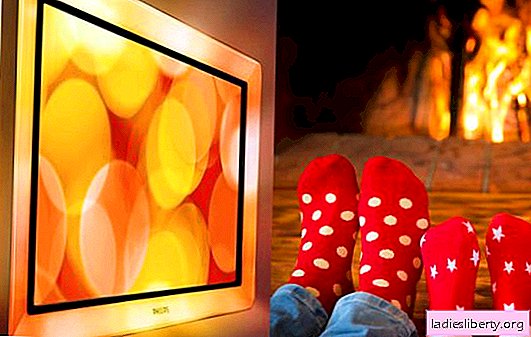
Infrared heaters for home comfort are becoming increasingly popular for a number of their advantages, but they also raise a lot of questions - how do they affect a person, can they be harmful?
Therefore, when it comes to buying such a device, it is important to have fairly complete and up-to-date information.
The use of infrared heaters for the home in general terms
Speaking about the properties of this type of heaters, it is natural to start with the very principle of their action. The infrared radiation generated by the devices from the energy that feeds them (most often, electric, although there are gas models) passes through the air to the objects located closest (and also to living creatures), warms them, and they, in turn, return this heat to the surrounding their atmosphere (in a similar way, the Sun warms the Earth).
Moreover, 90% of infrared radiation is spent on objects of this technique, 10% on air heating, while more traditional devices, for example, central heating batteries, work on the principle of consuming most of the energy to warm the surrounding air near them.
Due to this, an infrared (IR) heater can very quickly increase the temperature in the room, because the area of all surfaces covered by them is many times greater than what the area of, say, a conventional oil cooler could give.
Plus, the lion's share of heat will be concentrated precisely near heated objects, which allows you to create the most comfortable conditions in residential premises.
Therefore, it is highly recommended to choose infrared heaters for rooms whose decoration and furnishings contain a lot of materials with the lowest coefficient of thermal conductivity (and the higher it is, the worse the material retains heat), due to which a good temperature can last longer.
From wood, for example, first of all, cedar. Infrared waves, by the way, are able to heat the tree completely safely, without the risk of ignition.
IR heaters also have other advantages, for example:
• they allow you to warm up not the entire room as a whole, but only some specific part of it;
• do not dry the air (and this is one of the main problems in the microclimate of city apartments);
• do not burn oxygen;
• work silently;
• do not move air masses, as a result of which, accordingly, dust in the assortment cannot be raised.
As for the infrared rays themselves, they are a type of electromagnetic radiation with a wavelength of 0.74 to 2000 microns (microns), ultraviolet, x-ray and radio emission are peculiarly close to them, differing, in particular, in just the wavelength.
IR heaters come in various designs:
• ceiling;
• wall mounted;
• floor standing.
The latter are very often small, fairly lightweight and mobile (portable), which, of course, is very convenient.
The variety of models and ease of installation of even non-mobile devices allows them to organically fit into any interior design.
On the health benefits of infrared heaters
The comparison of IR heaters with the main star of our universe, which can be found at the beginning, can be continued by the fact that the state of the human body, deprived of long-term sunlight, does not change for the better, which is expressed both in a general deterioration in well-being, and in a weakening of natural defenses, and a slowdown in functioning nervous system and much more.
Therefore, this type of technique can be a preventive measure to improve health in conditions of deficit of the rays of the Sun, for example, in cold seasons.
The use of infrared heaters, in particular, is expressed in the fact that they:
• improve metabolic processes;
• promote blood circulation;
• support the nervous system (and improve mood, drive away fatigue);
• increase immunity;
• accelerate recovery from illness and injury.
And thanks to them, the concentration of harmful bacteria in the air is significantly reduced, so it is useful to launch heaters of this kind in influenza and acute respiratory infections seasons.
Which infrared heaters can be harmful
It is important to note that only short-term exposure to IR waves is beneficial to a person, that is, while the heater is working, you can stay in the room for a short time, or, for example, you need to turn it so that it warms a space where no one is at that time. Then, of course, you can move the device again.
For this reason, IR heaters are not recommended for installation in children's rooms - after all, a child may inadvertently violate safety precautions.
The minimum that an excessive stay in the sphere of influence of the heater threatens is general weakness and lethargy, and if it is ceiling-like then a headache, that is, symptoms are comparable to what can be observed in connection with a long stay in the scorching sun.
But this is just what happens from the best infrared heaters that emit mostly long waves (50-200 microns).
And there are still medium-wave ones, with radiation in the range of 2.5-50 microns. And if the former affects only the uppermost layer of the skin, “giving” it only benefits, the latter, when irradiated excessively, contributes to overdrying of the skin, over time, it loses elasticity, fades, becomes covered with wrinkles and traces of peeling.
But the short-wave heating equipment is the most harmful, under the influence of which, as a result of the penetration of rays into the body to a depth of 4 cm, a person can even get burns of I or II degree.
Also, they are exposed to the negative effects of the eye, as a result of which the retina can be damaged, the risk of cataracts increases.
In addition, with prolonged exposure, the development of specific processes of change, destruction (denaturation) of proteins in the human body is possible, which can lead to the most negative, sad consequences.
How to choose and use an infrared heater in your home without harm
Ideally, modern infrared heaters for home use, according to scientists, should work in the optimal range and the most safe for humans from 7 to 14 microns, which must be reflected in the technical passport of the device. But usually this scatter is somewhat wider.
The power of the device is recommended to be selected on the basis that 100 watts are required for heating 1 square meter. If a simple formula for calculating its capabilities shows less, there will be no desired heat, and if much more, the concentration of infrared radiation may not have a very good effect on health (even if it is long waves).
If you need a heater for the bathroom or sauna - you should take a ceramic, completely safe for use in a humid environment.
Continuous heating can damage (for example, cracking) some of the finishes used in the design of the room, materials, and sometimes paints in the paintings, so it is very advisable to clarify such points before purchasing IR heaters.
In order to avoid serious harm for pets, an infrared heater should never capture pets in the field of its work.











